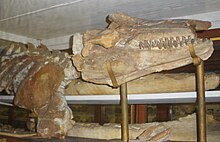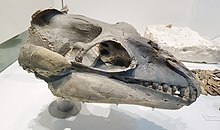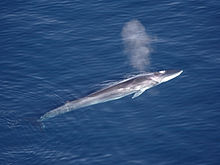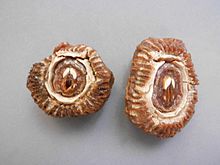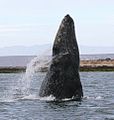Portal:Cetaceans
The Cetaceans Portal

Cetacea (/sɪˈteɪʃə/; from Latin cetus 'whale', from Ancient Greek κῆτος (kêtos) 'huge fish, sea monster') is an infraorder of aquatic mammals belonging to the order Artiodactyla that includes whales, dolphins, and porpoises. Key characteristics are their fully aquatic lifestyle, streamlined body shape, often large size and exclusively carnivorous diet. They propel themselves through the water with powerful up-and-down movement of their tail which ends in a paddle-like fluke, using their flipper-shaped forelimbs to maneuver.
While the majority of cetaceans live in marine environments, a small number reside solely in brackish water or fresh water. Having a cosmopolitan distribution, they can be found in some rivers and all of Earth's oceans, and many species inhabit vast ranges where they migrate with the changing of the seasons.
Cetaceans are famous for their high intelligence, complex social behaviour, and the enormous size of some of the group's members. For example, the blue whale reaches a maximum confirmed length of 29.9 meters (98 feet) and a weight of 173 tonnes (190 short tons), making it the largest known animal ever to have existed.
There are approximately 89 living species split into two parvorders: Odontoceti or toothed whales (containing porpoises, dolphins, other predatory whales like the beluga and the sperm whale, and the poorly understood beaked whales) and the filter feeding Mysticeti or baleen whales (which includes species like the blue whale, the humpback whale and the bowhead whale). Despite their highly modified bodies and carnivorous lifestyle, genetic and fossil evidence places cetaceans as nested within even-toed ungulates, most closely related to hippopotamus within the clade Whippomorpha. (Full article...)
-
Orcinus citoniensis is an extinct species of killer whale identified in the Late Pliocene of Italy and the Early Pleistocene of England. It was smaller than the modern killer whale (O. orca), 4 m (13 ft) versus 7 to 10 m (23 to 33 ft), and had around 8 more teeth in its jaw. It may have resembled the modern killer whale in appearance, and could represent a transitional species between the modern killer whale and other dolphins. O. citoniensis could have hunted fish and squid in pods, and coexisted with other large predators of the time such as the orcinine Hemisyntrachelus and the extinct shark Otodus megalodon. (Full article...) -

The false killer whale (Pseudorca crassidens) is a species of oceanic dolphin that is the only extant representative of the genus Pseudorca. It is found in oceans worldwide but mainly in tropical regions. It was first described in 1846 as a species of porpoise based on a skull, which was revised when the first carcasses were observed in 1861. The name "false killer whale" comes from having a skull similar to the orca (Orcinus orca), or killer whale.
The false killer whale reaches a maximum length of 6 m (20 ft), though size can vary around the world. It is highly sociable, known to form pods of up to 50 members, and can also form pods with other dolphin species, such as the common bottlenose dolphin (Tursiops truncatus). It can form close bonds with other species, as well as have sexual interactions with them. But the false killer whale has also been known to eat other dolphins, though it typically eats squid and fish. It is a deep-diver; maximum known depth is 927.5 m (3,043 ft); maximum speed is ~ 29 km/h (18 mph). (Full article...) -
Orca's Song is a 1987 picturebook written by Anne Cameron and illustrated in black and white by Nelle Olsen. Published by Harbour Publishing, the book is an adaptation of a Pacific Northwest Indigenous story. Orca's Song is a pourquoi story about a black orca who falls in love with an osprey; the two mate to create a baby orca with the black and white patterning found on the whales.
While some reviewers appreciated the art and text of the story, it received criticism from Indigenous authors and scholars who disputed Cameron's claim of sole authorship and copyright for the story. Consequently, reprints of the book began to attribute the storyteller Klopinum for the story's inspiration although Cameron retained sole authorship credit and copyright. The story has also been noted as an early example of a lesbian relationship (between Orca and Osprey) in picturebook literature and one of the few such picturebooks published before 2000 to lack a moralising tone. (Full article...) -
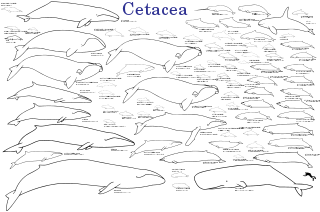
Species of the infraorder Cetacea
The evolution of cetaceans is thought to have begun in the Indian subcontinent from even-toed ungulates (Artiodactyla) 50 million years ago (mya) and to have proceeded over a period of at least 15 million years. Cetaceans are fully aquatic marine mammals belonging to the order Artiodactyla and branched off from other artiodactyls around 50 mya. Cetaceans are thought to have evolved during the Eocene (56-34 mya), the second epoch of the present-extending Cenozoic Era. Molecular and morphological analyses suggest Cetacea share a relatively recent closest common ancestor with hippopotami and that they are sister groups. Being mammals, they surface to breathe air; they have five finger bones (even-toed) in their fins; they nurse their young; and, despite their fully aquatic life style, they retain many skeletal features from their terrestrial ancestors. Research conducted in the late 1970s in Pakistan revealed several stages in the transition of cetaceans from land to sea.
The two modern parvorders of cetaceans – Mysticeti (baleen whales) and Odontoceti (toothed whales) – are thought to have separated from each other around 28–33 mya in a second cetacean radiation, the first occurring with the archaeocetes. The adaptation of animal echolocation in toothed whales distinguishes them from fully aquatic archaeocetes and early baleen whales. The presence of baleen in baleen whales occurred gradually, with earlier varieties having very little baleen, and their size is linked to baleen dependence (and subsequent increase in filter feeding). (Full article...) -
Janjucetus is an extinct genus of cetacean, and a basal baleen whale (Mysticeti), from the Late Oligocene around 25 million years ago (mya) off south-east Australia, containing one species J. hunderi. Unlike modern mysticetes, it possessed large teeth for gripping and shredding prey, and lacked baleen, and so was likely to have been a predator that captured large single prey animals rather than filter feeding. However, its teeth may have interlocked, much like those of the modern-day filter-feeding crabeater seal (Lobodon carcinophaga), which would have allowed some filter-feeding behaviour. Its hunting behaviour was probably similar to the modern-day leopard seal (Hydrurga leptonyx), probably eating large fish. Like baleen whales, Janjucetus could not echolocate; however, it did have unusually large eyes, and so probably had an acute sense of vision. The only specimen was found on the Jan Juc beach, where the remains of the extinct whales Mammalodon, Prosqualodon and Waipatia have also been discovered. (Full article...) -

The humpback whale (Megaptera novaeangliae) is a species of baleen whale. It is a rorqual (a member of the family Balaenopteridae) and is the only species in the genus Megaptera. Adults range in length from 14–17 m (46–56 ft) and weigh up to 40 metric tons (44 short tons). The humpback has a distinctive body shape, with long pectoral fins and tubercles on its head. It is known for breaching and other distinctive surface behaviors, making it popular with whale watchers. Males produce a complex song typically lasting 4 to 33 minutes.
Found in oceans and seas around the world, humpback whales typically migrate up to 16,000 km (9,900 mi) each year. They feed in polar waters and migrate to tropical or subtropical waters to breed and give birth. Their diet consists mostly of krill and small fish, and they use bubbles to catch prey. They are promiscuous breeders, with both sexes having multiple partners. Orcas are the main natural predators of humpback whales. (Full article...) -
Rice's whale (Balaenoptera ricei), also known as the Gulf of Mexico whale, is a species of baleen whale endemic to the northern Gulf of Mexico. Initially identified as a subpopulation of the Bryde's whale, genetic and skeletal studies found it to be a distinct species by 2021. In outward appearance, it is virtually identical to the Bryde's whale. Its body is streamlined and sleek, with a uniformly dark charcoal gray dorsal and pale to pinkish underside. A diagnostic feature often used by field scientists to distinguish Rice's whales from whales other than the Bryde's whale is the three prominent ridges that line the top of its head. The species can be distinguished from the Bryde's whale by the shape of the nasal bones, which have wider gaps due to a unique wrapping by the frontal bones, its unique vocal repertoire, and genetic differences.
It is a medium-sized baleen whale that grows up to 12.65 meters (41.5 ft) in length and weighs up to 13.87–27.2 metric tons (13.65–26.77 long tons; 15.29–29.98 short tons). The Rice's whale inhabits a restricted stretch along the continental slope in the northeastern part of the Gulf of Mexico between depths of 150–410 meters (490–1,350 ft) off the coast of western Florida, although some whales have been sighted in the northwestern portions and the species may have inhabited a wider distribution throughout the Gulf in historical times. It does not migrate but remains within this area year-round. Little is known about the feeding behavior of Rice's whales, but data from a tagged individual revealed a diel vertical diving pattern, in which the whale spends most of the day feeding at or near the seafloor at depths of up to 271 meters (889 ft) and night at the surface. The whale's diet remains unknown, but lanternfish and hatchetfish are suspected prey. (Full article...) -
Zygophyseter varolai is an extinct sperm whale that lived during the Tortonian age of the Late Miocene 11.2 to 7.6 million years ago. It is known from a single specimen from the Pietra Leccese Formation in Italy. It was a member of a stem group of fossil macroraptorial sperm whales (often shortened to "raptorial") also including Brygmophyseter, Acrophyseter, and Livyatan. It probably grew to be around 6.5 to 7 meters (21 to 23 ft) in length and shared some characteristics with other raptorials, such as large teeth with tooth enamel that were functional in both the upper and lower jaws which the modern sperm whale (Physeter macrocephalus) lacks. It also had a beak, the ability to echolocate prey, and could have probably swum faster than the modern-day sperm whale which can reach 4 kilometers per hour (2.5 mph). These were probably used in the capture of large prey, such as large fish, seals, and whales. In fact, its common name, the killer sperm whale, refers to its feeding habits that would have had a resemblance to the modern-day killer whale (Orcinus orca). (Full article...) -
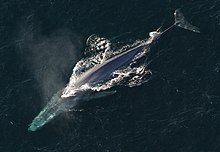
The blue whale (Balaenoptera musculus) is a marine mammal and a baleen whale. Reaching a maximum confirmed length of 29.9 meters (98 ft) and weighing up to 199 tonnes (196 long tons; 219 short tons), it is the largest animal known ever to have existed. The blue whale's long and slender body can be of various shades of greyish-blue dorsally and somewhat lighter underneath. Four subspecies are recognized: B. m. musculus in the North Atlantic and North Pacific, B. m. intermedia in the Southern Ocean, B. m. brevicauda (the pygmy blue whale) in the Indian Ocean and South Pacific Ocean, and B. m. indica in the Northern Indian Ocean. There is also a population in the waters off Chile that may constitute a fifth subspecies.
In general, blue whale populations migrate between their summer feeding areas near the poles and their winter breeding grounds near the tropics. There is also evidence of year-round residencies, and partial or age/sex-based migration. Blue whales are filter feeders; their diet consists almost exclusively of krill. They are generally solitary or gather in small groups, and have no well-defined social structure other than mother–calf bonds. The fundamental frequency for blue whale vocalizations ranges from 8 to 25 Hz and the production of vocalizations may vary by region, season, behavior, and time of day. Orcas are their only natural predators. (Full article...) -
Brygmophyseter, known as the biting sperm whale, is an extinct genus of toothed whale in the sperm whale family with one species, B. shigensis. When it was first described in 1994, the species was placed in the genus Scaldicetus based on tooth morphology, but this was later revised in 1995. In 2006, it was classified into the genus Naganocetus, which is considered to be a junior synonym. The only known specimen, a nearly complete skeleton, was dated to be around 16–15 million years old (middle Miocene). Brygmophyseter is thought to have been 6.5–7 meters (21–23 ft) long, and it probably had 11 or 12 teeth in the upper and lower jaws. Brygmophyseter is part of a group of macroraptorial sperm whales (often shortened to "raptorial") which tended to be apex predators using their large teeth to catch struggling prey such as whales. It had a spermaceti organ which was probably used for biosonar like in the modern sperm whale. The whale has made an appearance on The History Channel's TV series Jurassic Fight Club. (Full article...) -
The fin whale (Balaenoptera physalus), also known as the finback whale or common rorqual, is a species of baleen whale and the second-longest cetacean after the blue whale. The biggest individual reportedly measured 26 m (85 ft) in length, with a maximum recorded weight of 77,000–81,000 kg (170,000–179,000 lb). The fin whale's body is long, slender and brownish-gray in color, with a paler underside to appear less conspicuous from below (countershading).
At least two recognized subspecies exist, one in the North Atlantic and one across the Southern Hemisphere. It is found in all the major oceans, from polar to tropical waters, though it is absent only from waters close to the pack ice at the poles and relatively small areas of water away from the open ocean. The highest population density occurs in temperate and cool waters. Its prey mainly consists of smaller schooling fish, small squid, or crustaceans, including copepods and krill. Mating takes place in temperate, low-latitude seas during the winter. Fin whales are often observed in pods of 6–10 animals, with whom they communicate utilizing frequency-modulated sounds, ranging from 16 to 40 hertz. (Full article...) -
Whale barnacles are species of acorn barnacle that belong to the family Coronulidae. They typically attach to baleen whales, and sometimes settle on toothed whales. The whale barnacles diverged from the turtle barnacles about three million years ago.
Whale barnacles passively filter food, using tentacle-like cirri, as the host swims through the water. The arrangement is generally considered commensal as it is done at no cost or benefit to the host. However, some whales may make use of the barnacles as protective armor or for inflicting more damage while fighting, which would make the relationship mutualistic where both parties benefit; alternatively, some species may just increase the drag that the host experiences while swimming, making the barnacles parasites. (Full article...) -
Orcinus meyeri is a fossil species of Orcinus (killer whales) found in the Early Miocene deposits of southern Germany, known from two jaw fragments and 18 isolated teeth. It was originally described as Delphinus acutidens in 1859, but reclassified in 1873. Its validity is disputed, and it may be a synonymous with the ancient sperm whale Physeterula dubusi. It was found in the Alpine town of Stockach in the Molasse basin, which was a coastal area with strong tidal currents. (Full article...) -
Bottlenose dolphins are toothed whales in the genus Tursiops. They are common, cosmopolitan members of the family Delphinidae, the family of oceanic dolphins. Molecular studies show the genus contains three species: the common bottlenose dolphin (Tursiops truncatus), the Indo-Pacific bottlenose dolphin (Tursiops aduncus), and Tamanend's bottlenose dolphin (Tursiops erebennus). Others, like the Burrunan dolphin (Tursiops (aduncus) australis), may be alternately considered their own species or be subspecies of T. aduncus. Bottlenose dolphins inhabit warm and temperate seas worldwide, being found everywhere except for the Arctic and Antarctic Circle regions. Their name derives from the Latin tursio (dolphin) and truncatus for the truncated teeth (the type specimen was old and had worn down teeth; this is not a typical characteristic of most members of the species).
Numerous investigations of bottlenose dolphin intelligence have been conducted, examining mimicry, use of artificial language, object categorization, and self-recognition. They can use tools (sponging; using marine sponges to forage for food sources they normally could not access) and transmit cultural knowledge from generation to generation, and their considerable intelligence has driven interaction with humans. Bottlenose dolphins gained popularity from aquarium shows and television programs such as Flipper. They have also been trained by militaries to locate sea mines or detect and mark enemy divers. In some areas, they cooperate with local fishermen by driving fish into their nets and eating the fish that escape. Some encounters with humans are harmful to the dolphins: people hunt them for food, and dolphins are killed inadvertently as a bycatch of tuna fishing and by getting caught in crab traps. (Full article...) -

The dusky dolphin (Lagenorhynchus obscurus) is a dolphin found in coastal waters in the Southern Hemisphere. Its specific epithet is Latin for "dark" or "dim". It is very closely genetically related to the Pacific white-sided dolphin, but current scientific consensus holds they are distinct species. The dolphin's range is patchy, with major populations around South America, southwestern Africa, New Zealand, and various oceanic islands, with some sightings around southern Australia and Tasmania. The dusky dolphin prefers cool currents and inshore waters, but can also be found offshore. It feeds on a variety of fish and squid species and has flexible hunting tactics. The dusky dolphin is known for its remarkable acrobatics, having a number of aerial behaviours. The status of the dolphin is unknown, but it has been commonly caught in gill nets. (Full article...)
Selected picture

A U.S. Navy Marine Mammal Program bottlenose dolphin named K-Dog wearing a locating pinger, performed mine clearance work in the Persian Gulf during the Iraq War.
The United States and Russian militaries have trained and employed dolphins for several reasons. Such military dolphins can be trained to rescue lost divers or to locate underwater mines. Military dolphins were used during the First and Second Gulf War.
More did you know...

- ...the Orca, is the fastest swimmer of all the cetaceans and can reach speeds of more than 50 km/h (30 mph) while hunting.
- ...some cetaceans can dive to depths of more than one kilometre (0.6 mi) and stay there for more than an hour.
- ...newborn cetacean calves do not have the skills to swim for long periods or to accelerate away from danger, so they swim in the slipstream of their mothers, enabling the mother to protect her calf.
- ...all cetaceans have a blubber layer — a layer of fat under the skin. In most dolphins, this layer is about one quarter to one third of the total body weight, but in southern right whales nearly half of its weight (up to 50 tons) will be blubber.
- ...most whales and dolphins live long lives. Wild bottlenose dolphins live well into their forties, while some of the larger whales live in excess of 80 years!
Things you can do..
|
|
Here are some Cetaceans WikiProject tasks you can do.
|
General images -
-
Bryde's whale (rorqual) (from Baleen whale)
-
Common minke whale illustration
-
Accessory baleen plates taper off into small hairs (from Baleen whale)
-
Atlantic white-sided dolphin caught in a drive hunt in Hvalba on the Faroe Islands being taken away with a forklift (from Toothed whale)
-
Eden's whale illustration
-
Their eyes are relatively small for their size.
-
North Atlantic right whale illustration
-
Possible relationships between cetaceans and other ungulate groups. (from Evolution of cetaceans)
-
Biosonar by cetaceans (from Toothed whale)
-
Fossil of Squalodon (from Toothed whale)
-
Species of the infraorder Cetacea (from Evolution of cetaceans)
-
Baleen whales vary considerably in size and shape, depending on their feeding behavior. (from Baleen whale)
-
Sei whale illustration
-
Japanese scientific whaling on a pair of Antarctic minke whales (from Baleen whale)
-
Diagram illustrating sound generation, propagation and reception in a toothed whale. Outgoing sounds are red and incoming ones are green (from Toothed whale)
-
Fin whale illustration
-
World population graph of blue whales
-
Restoration of Janjucetus hunderi (from Baleen whale)
-
Blue whale illustration
-
Orca hunting a Weddell seal (from Toothed whale)
-
Female right whale with calf
-
Acrophyseter skull (from Evolution of cetaceans)
-
Bowhead whale illustration
-
The nose of the whale is filled with a waxy substance that was widely used in candles, oil lamps, and lubricants (from Toothed whale)
-
A protest against Japan's scientific whaling
-
Features of a sperm whale skeleton (from Toothed whale)
-
Orange whale lice on a right whale
-
An orca by the name of Ulises performing at SeaWorld, 2009 (from Toothed whale)
-
South Atlantic right whale illustration
-
Humpback whale illustration
-
Spectrogram of dolphin vocalizations. Whistles, whines, and clicks are visible as upside down V's, horizontal striations, and vertical lines, respectively. (from Toothed whale)
-
Archaeomysticetes, like Janjucetus, had teeth.
-
Antarctic minke whale illustration
-
The skeleton of a bowhead whale with the hind limb and pelvic bone structure circled in red. This bone structure stays internal during the entire life of the species. (from Evolution of cetaceans)
-
A phylogenetic tree showing the relationships among cetacean families. (from Evolution of cetaceans)
-
Pygmy right whale illustration
-
Pakicetus attocki skeleton (from Evolution of cetaceans)
-
Anatomy of the bottlenose dolphin (from Toothed whale)
-
Megalodon hunted Miocene baleen whales (from Baleen whale)
-
Dolphins (aquatic mammals) and ichthyosaurs (extinct marine reptiles) share a number of unique adaptations for fully aquatic lifestyle and are frequently used as extreme examples of convergent evolution (from Evolution of cetaceans)
-
The heart of a blue whale with a person standing next to it
-
Humpback whales lunge-feeding in the course of bubble net fishing
-
Archaeocetes (like this Basilosaurus) had a heterodont dentition (from Evolution of cetaceans)
-
The remains of a North Atlantic right whale after it collided with a ship propeller
-
Gray whale illustration
-
A humpback whale skeleton. Notice how the jaw is split into two.
Did you know (auto-generated)

- ... that Celia Kaye won the Golden Globe Award for Most Promising Newcomer in 1965 for her starring role in Island of the Blue Dolphins?
- ... that the South Asian river dolphin is nearly blind and relies on echolocation for navigation?
- ... that the three dolphins on the coat of arms of Anguilla represent "unity, strength and endurance", which is also the motto of the territory?
- ... that one can swim with humpback whales in the Niue Nukutuluea Multiple-Use Marine Park?
- ... that one of the first researchers to propose dolphin-assisted therapy for humans later renounced it?
Selected media
List articles
Related portals
WikiProjects

The content you are reading was created by Wikipedia volunteers. See WikiProject Cetaceans for more.
- See also: Wikispecies, a Wikimedia project dedicated to the classification of species.
Cetacean articles
Categories
For additional lists of marine life-related featured articles and good articles see:
Associated Wikimedia
The following Wikimedia Foundation sister projects provide more on this subject:
-
Commons
Free media repository -
Wikibooks
Free textbooks and manuals -
Wikidata
Free knowledge base -
Wikinews
Free-content news -
Wikiquote
Collection of quotations -
Wikisource
Free-content library -
Wikispecies
Directory of species -
Wikiversity
Free learning tools -
Wikivoyage
Free travel guide -
Wiktionary
Dictionary and thesaurus


